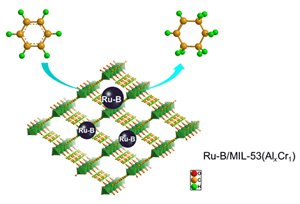| [1] Zhou, G. B.; Tan, X. H.; Pei, Y.; Fan, K. N.; Qiao, M. H.; Sun, B.; Zong, B. N. ChemCatChem 2013, 5, 2425.
[2] Odenbrand, C. U. I.; Andersson, S. L. T. J. Chem. Technol. Biotechnol. 1982, 32, 365.
[3] Wang, J. Q.; Guo, P. J.; Qiao, M. H.; Yan, S. R.; Fan, K. N. Acta Chim. Sinica 2004, 62, 1765.(王建强, 郭平均, 乔明华, 闫世润, 范康年, 化学学报, 2004, 62, 1765.)
[4] Wang, W. T.; Liu, H. Z.; Ding, G. D.; Zhang, P.; Wu, T. B.; Jiang, T.; Han, B. X. ChemCatChem 2012, 4, 1836.
[5] Wang, J. Q.; Wang, Y. Z.; Xie, S. H.; Qiao, M. H.; Li, H. X.; Fan, K. N. Appl. Catal. A 2004, 272, 29.
[6] Huang, G.; Chen, Y. Z.; Jiang, H. L. Acta Chim. Sinica 2016, 74, 113.(黄刚, 陈玉贞, 江海龙, 化学学报, 2016, 74, 113.)
[7] Rosi, N. L.; Eckert, J.; Eddaoudi, M.; Vodak, D. T.; Kim, J.; O'Keeffe, M.; Yaghi, O. M. Science 2003, 300, 1127.
[8] Sun, L.; Deng, W. Q. Acta Chim. Sinica 2015, 73, 579.(孙磊, 邓伟侨, 化学学报, 2015, 73, 579.)
[9] Li, J. R.; Kuppler, R. J.; Zhou, H. C. Chem. Soc. Rev. 2009, 38, 1477.
[10] Lee, J.; Farha, O. K.; Roberts, J.; Scheidt, K. A.; Nguyen, S. T.; Hupp, J. T. Chem. Soc. Rev. 2009, 38, 1450.
[11] Ren, H.; Zhu, G. S. Acta Chim. Sinica 2015, 73, 587.(任浩, 朱广山, 化学学报, 2015, 73, 587.)
[12] Liu, Y.; Mo, K.; Cui, Y. Inorg. Chem. 2013, 52, 10286.
[13] Uemura, T.; Kitaura, R.; Ohta, Y.; Nagaoka, M.; Kitagawa, S. Angew. Chem. Int. Ed. 2006, 45, 4112.
[14] Zhao, H. H.; Song, H. L.; Chou, L. J. Inorg. Chem. Commun. 2012, 15, 261.
[15] Wan, Y.; Chen, C.; Xiao, W. M.; Jian, L. J.; Zhang, N. Microporous Mesoporous Mater. 2013, 171, 9.
[16] Guo, Z. Y.; Xiao, C. X.; Maligal-Ganesh, R. V.; Zhou, L.; Goh, T. W.; Li, X. L.; Tesfagaber, D.; Thiel, A.; Huang, W. Y. ACS Catal. 2014, 4, 1340.
[17] Luz, I.; Rösler, C.; Epp, K.; Xamena, F. L.; Fischer, R. Eur. J. Inorg. Chem. 2015, 23, 3904.
[18] Chen, D. C.; Huang, M.; He, S.; He, S. L.; Ding, L. P.; Wang, Q.; Yu, S. M.; Miao, S. D. Appl. Clay Sci. 2016, 119, 109.
[19] Tan, X. H.; Zhou, G. B.; Dou, R. F.; Pei, Y.; Fan, K. N.; Qiao, M. H.; Sun, B.; Zong, B. N. Acta Phys.-Chim. Sin. 2014, 30, 932.(谭晓荷, 周功兵, 窦镕飞, 裴燕, 范康年, 乔明华, 孙斌, 宗保宁, 物理化学学报, 2014, 30, 932.)
[20] Serre, C.; Millange, F.; Thouvenot, C.; Noguès, M.; Marsolier, G.; Louër D.; Férey, G. J. Am. Chem. Soc. 2002, 124, 13519.
[21] Loiseau, T.; Serre, C.; Huguenard, C.; Fink, G.; Taulelle, F.; Henry, M.; Bataille, T.; Férey, G. Chem.-Eur. J. 2004, 10, 1373.
[22] Zhao, Y. J.; Zhang, J. L.; Han, B. X.; Song, J. L.; Li, J. S.; Wang, Q. Angew. Chem. Int. Ed. 2011, 50, 636.
[23] Liu, H. Z.; Liang, S. G.; Wang, W. T.; Jiang, T.; Han, B. X. J. Mol. Catal. A 2011, 341, 35.
[24] Millange, F.; Serre, C.; Férey, G. Chem. Commun. 2002, (8), 822.
[25] Sun, Z. G.; Li, G.; Liu, L. P.; Liu, H. O. Catal. Commun. 2012, 27, 200.
[26] Liu, J. L.; Zhu, L. J.; Pei, Y.; Zhuang, J. H.; Li, H.; Li, H. X.; Qiao, M. H.; Fan, K. N. Appl. Catal. A 2009, 353, 282.
[27] Larichev, Y. V.; Moroz, B. L.; Zaikovskii, V. I.; Yunusov, S. M.; Kalyuzhnaya, E. S.; Shur, V. B.; Bukhtiyarov, V. I. J. Phys. Chem. C 2007, 111, 9427.
[28] Mazzieri, V.; Coloma-Pascual, F.; Arcoya, A.; L'Argentière, P.; F?goli, N. Appl. Surf. Sci. 2003, 210, 222.
[29] Xie, S. H.; Qiao, M. H.; Li, H. X.; Wang, W. J.; Deng, J. F. Appl. Catal. A 1999, 176, 129.
[30] Pei, Y.; Zhou, G. B.; Luan, N.; Zong, B. N.; Qiao, M. H.; Tao, F. Chem. Soc. Rev. 2012, 41, 8140.
[31] Pei, Y.; Guo, P. J.; Qiao, M. H.; Li, H. X.; Wei, S. Q.; He, H. Y.; Fan, K. N. J. Catal. 2007, 248, 303.
[32] Wang, X. G.; Yan, W. S.; Zhong, W. J.; Zhang, X. Y.; Wei, S. Q. Chem. J. Chin. Univ. 2001, 22, 349.(王晓光, 闫文胜, 钟文杰, 张新夷, 韦世强, 高等学校化学学报, 2001, 22, 349.)
[33] Bu, J.; Wang, J. Q.; Qiao, M. H.; Yan, S. R.; Li, H. X.; Fan, K. N. Acta Chim. Sinica 2007, 65, 1338.(卜娟, 王建强, 乔明华, 闫世润, 李和兴, 范康年, 化学学报, 2007, 65, 1338.)
[34] Ronchin, L.; Toniolo, L. Catal. Today 1999, 48, 255.
[35] Schwab, F.; Lucas, M.; Claus, P. Angew. Chem. Int. Ed. 2011, 50, 10453.
[36] Spod, H.; Lucas, M.; Claus, P. Catalysts 2015, 5, 1756.
[37] Sun, H. J.; Li, S. H.; Zhang, Y. X.; Jiang, H. B.; Qu, L. L.; Liu, S. C. Liu, Z. Y. Chin. J. Catal. 2013, 34, 1482.
[38] Zhou, G. B.; Dou, R. F.; Bi, H. Z.; Xie, S. H.; Pei, Y.; Fan, K. N.; Qiao, M. H.; Sun, B.; Zong, B. N. J. Catal. 2015, 332, 119.
[38] Trung, T. K.; Trens, P.; Tanchoux, N.; Bourrelly, S.; Llewellyn, P. L.; Loera-Serna, S.; Serre, C.; Loiseau, T.; Fajula, F. O.; Férey, G. R. J. Am. Chem. Soc. 2008, 130, 16926. |
